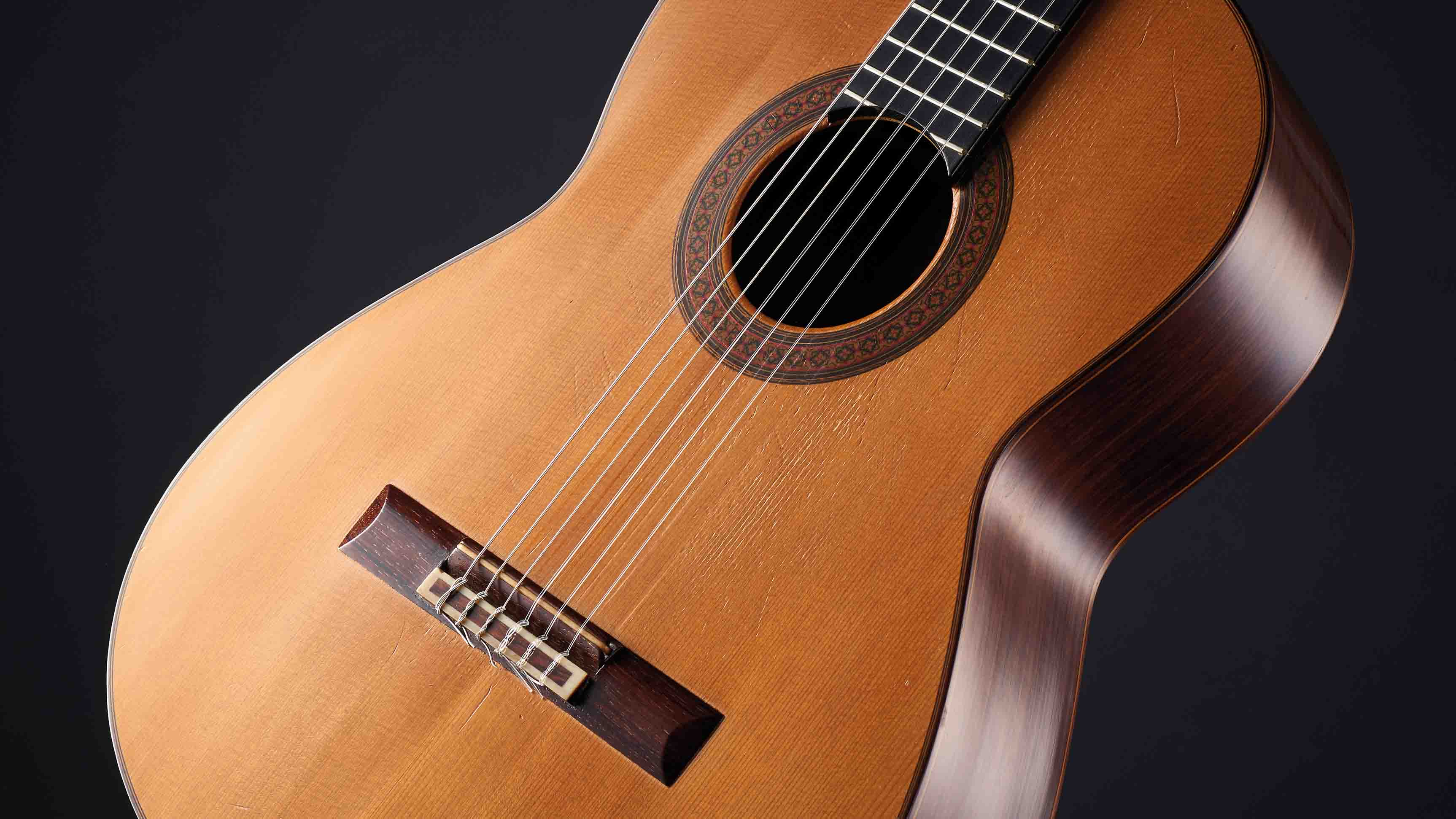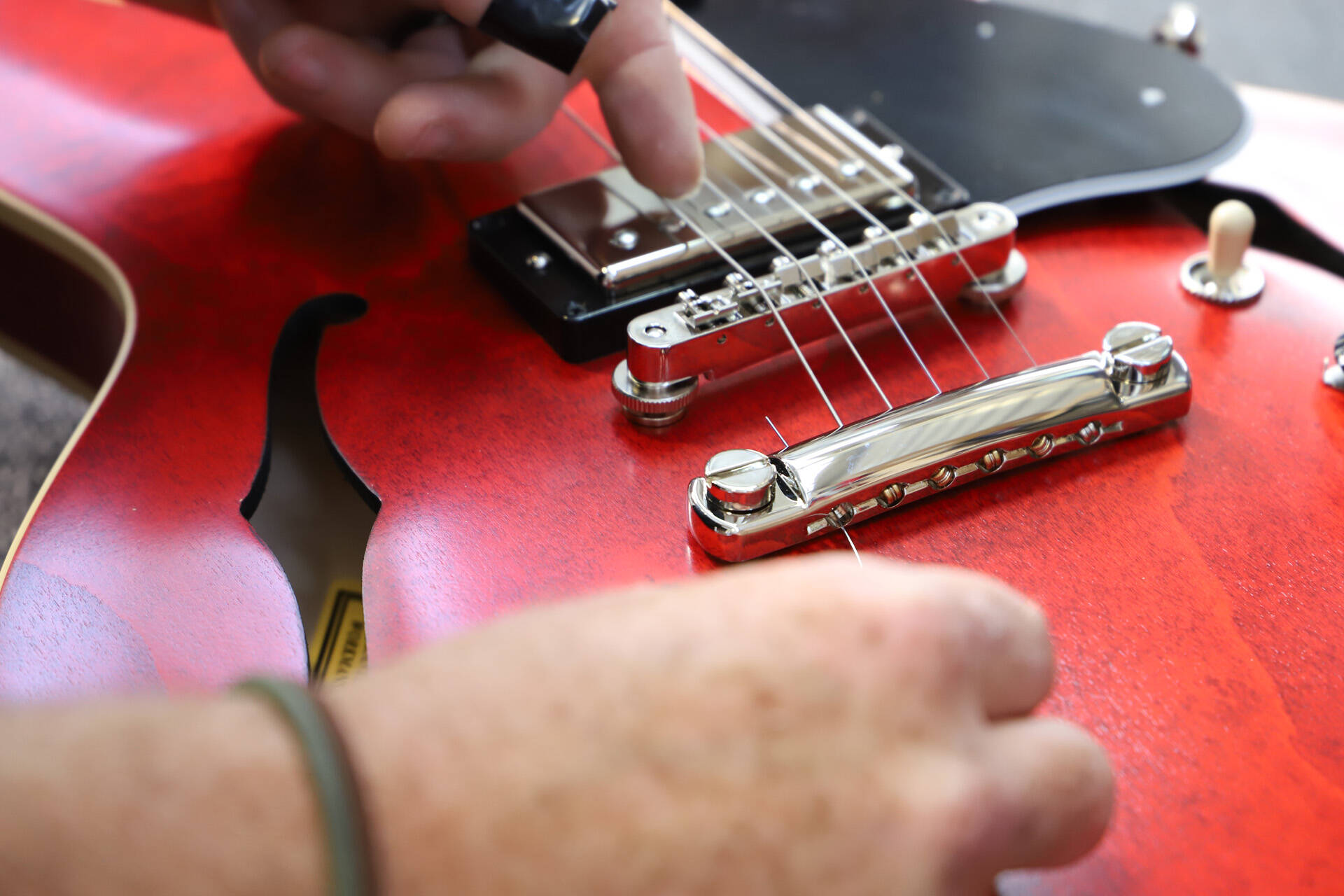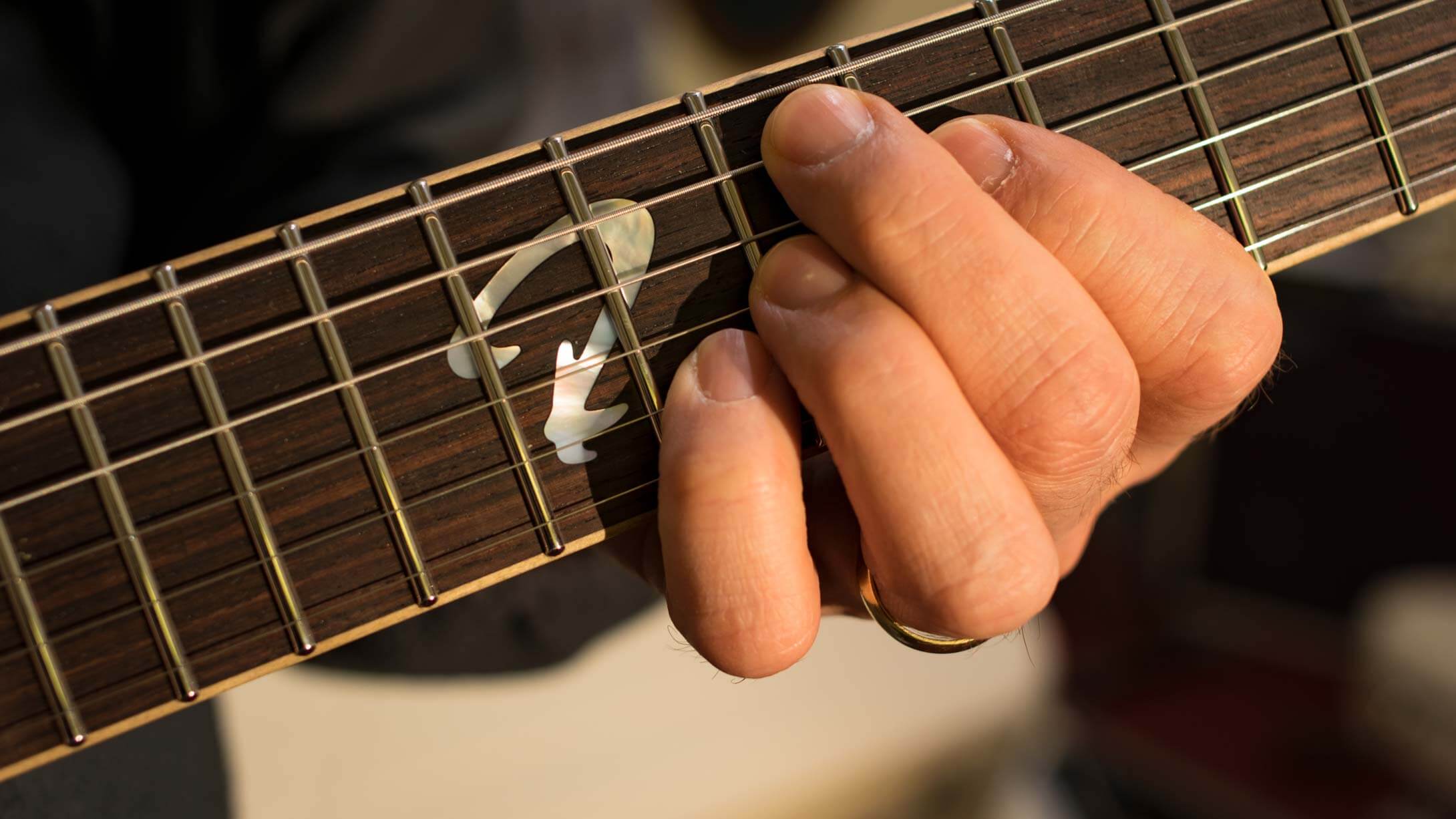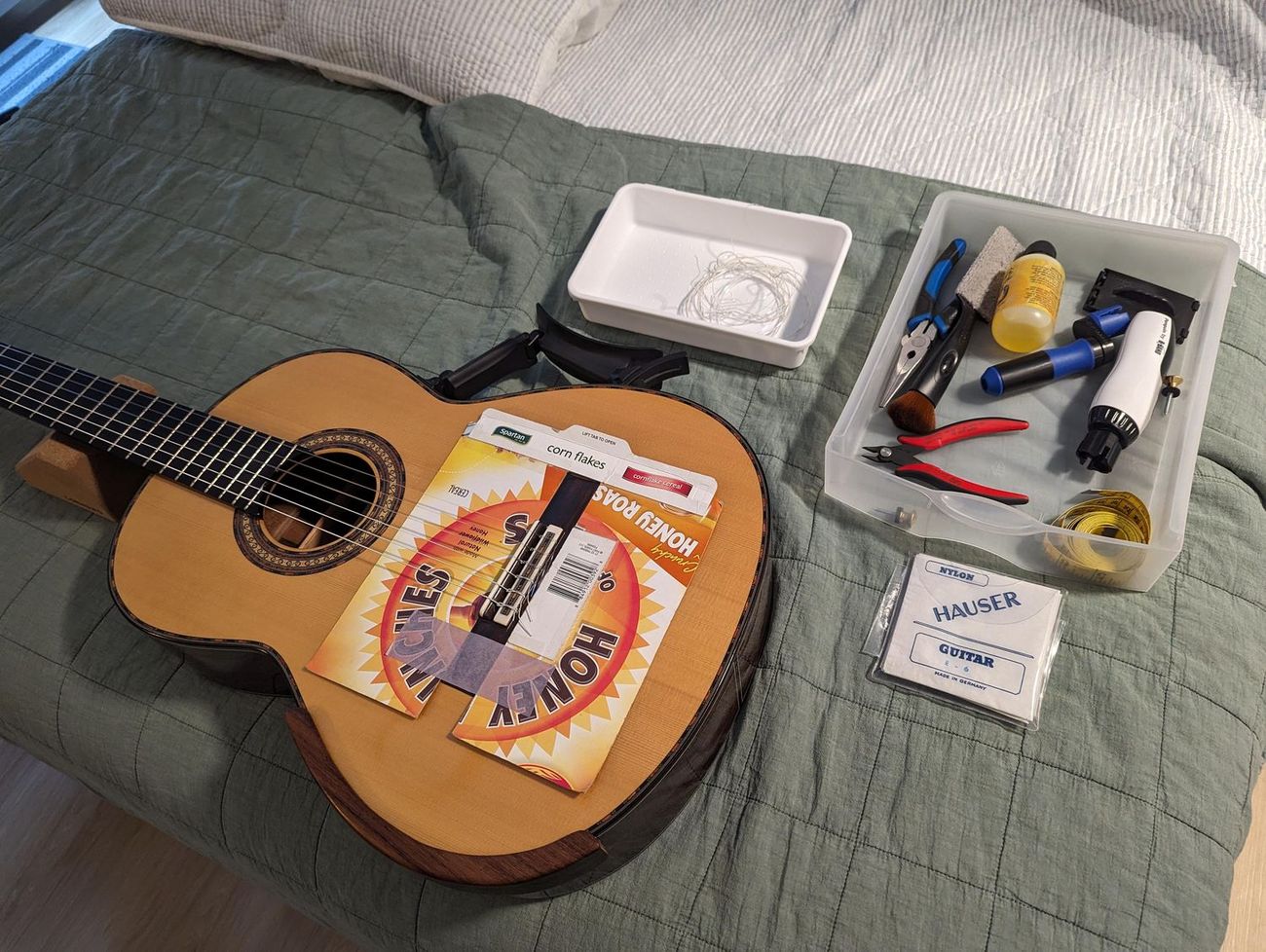Home>Instruments>Guitar>How To Mute A Guitar String
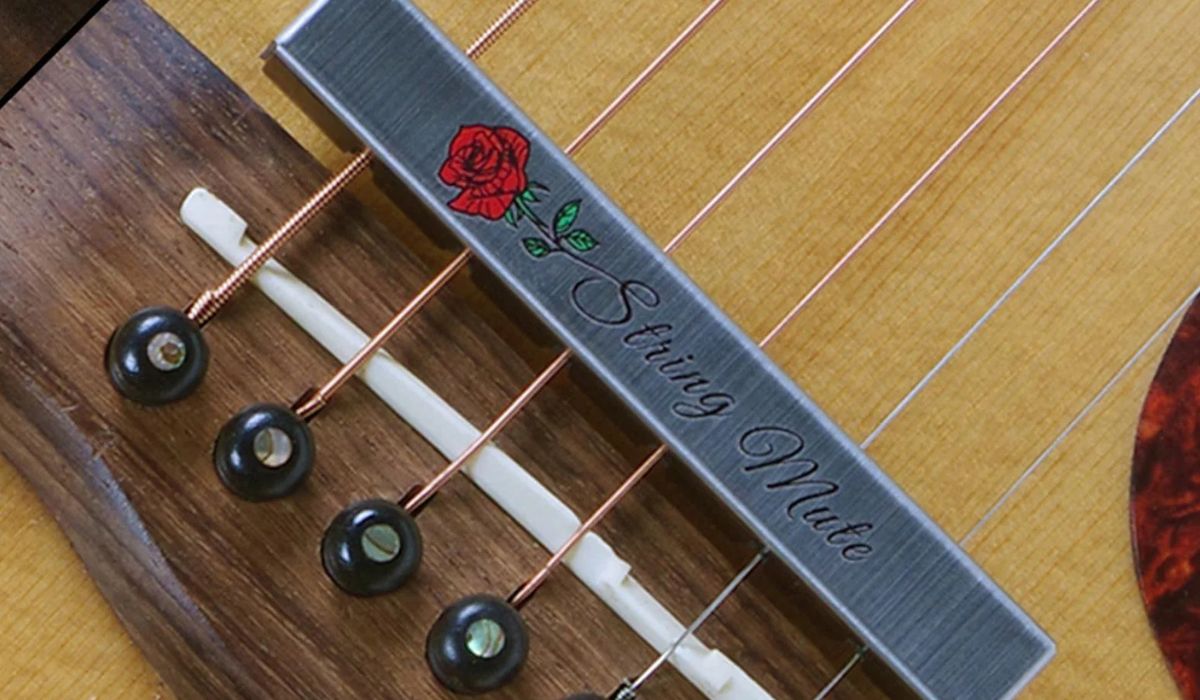

Guitar
How To Mute A Guitar String
Published: February 13, 2024
Learn how to mute a guitar string and improve your guitar playing skills with our step-by-step guide. Master the technique and enhance your guitar performance today!
(Many of the links in this article redirect to a specific reviewed product. Your purchase of these products through affiliate links helps to generate commission for AudioLover.com, at no extra cost. Learn more)
Table of Contents
Introduction
Guitar string muting is a fundamental technique that adds depth and dynamics to your playing. Whether you're a novice or an experienced guitarist, mastering the art of muting can significantly enhance your musical expression. By selectively silencing or dampening strings, you can produce clean, crisp notes and prevent unwanted string resonance, resulting in a more professional and polished sound.
Understanding the intricacies of muting techniques is crucial for any guitarist aiming to elevate their playing style. This article will delve into the various methods and approaches to effectively mute guitar strings, equipping you with the knowledge and skills to refine your sound and musicality.
Muting strings on a guitar involves a combination of precise hand positioning, finger pressure, and strategic use of accessories. From palm muting to fret-hand muting, the diverse array of muting techniques offers a spectrum of tonal possibilities. Additionally, integrating muting into your playing can help you achieve a tighter and more controlled sound, particularly in genres like rock, metal, and funk.
In the subsequent sections, we will explore the foundational principles of guitar string muting, unravel the nuances of different muting techniques, and discuss the role of accessories in enhancing your muting capabilities. Furthermore, practical tips and insights will be shared to aid you in honing your muting proficiency and unleashing the full potential of your guitar playing.
Embark on this insightful journey into the realm of guitar string muting, and discover the transformative impact it can have on your musical prowess. Whether you're aiming to add rhythmic punch, eliminate unwanted string noise, or infuse your playing with newfound clarity, mastering the art of muting is a pivotal step in your evolution as a guitarist. Let's dive into the intricacies of this essential technique and unlock its boundless creative possibilities.
Understanding the Basics of Guitar String Muting
At its core, guitar string muting involves the deliberate suppression of string vibrations to control the sustain and articulation of notes. By employing muting techniques, guitarists can effectively manage the duration and clarity of each note, resulting in a more controlled and refined sound.
One of the primary forms of muting is palm muting, where the fleshy part of the picking hand’s palm is placed lightly on the strings near the bridge. This technique yields a muted, percussive sound, ideal for creating rhythmic accents and emphasizing staccato passages. Palm muting is commonly utilized in genres such as rock, punk, and metal to imbue the music with a distinctive edge and drive.
Another essential aspect of muting involves the fret-hand’s dexterity in dampening strings. This can be achieved by partially releasing pressure on the fretting hand while maintaining contact with the strings, resulting in a muted, percussive effect. By mastering this technique, guitarists can seamlessly transition between sustained notes and muted, rhythmic phrases, adding depth and dimension to their playing.
Understanding the physics of string vibration is crucial for effective muting. When a string is plucked, it vibrates not only along its entire length but also in segments, known as harmonics. Muting unwanted harmonics is essential for achieving a clean and articulate sound. This can be accomplished through precise hand placement and pressure control, ensuring that only the intended notes resonate while extraneous noise is suppressed.
Furthermore, the concept of muting extends beyond individual notes to encompass chordal playing. Guitarists often employ selective muting to prevent unintended strings from sounding within a chord, resulting in a more defined and sonically pleasing chordal voicing. This technique is particularly valuable in intricate chord progressions and arpeggiated patterns, allowing for greater clarity and precision in the musical arrangement.
By grasping the fundamental principles of guitar string muting, you lay the groundwork for a more nuanced and expressive playing style. The ability to manipulate string resonance and control the onset and decay of notes empowers you to convey emotion and rhythm with unparalleled finesse. As we delve deeper into the diverse techniques for muting guitar strings, you’ll uncover a wealth of possibilities to enrich your musical journey.
Techniques for Muting Guitar Strings
Mastering the various techniques for muting guitar strings is essential for refining your playing and expanding your sonic palette. Whether you’re aiming to imbue your riffs with percussive power or seamlessly transition between clean and muted passages, a diverse array of muting methods awaits your exploration.
Palm Muting: This foundational technique involves lightly resting the picking hand’s palm on the strings near the bridge while picking or strumming. By adjusting the proximity of the palm to the bridge, you can control the degree of muting, from subtle dampening to pronounced percussiveness. Palm muting is a staple in genres like metal and punk, adding a gritty, rhythmic edge to the music.
Fret-Hand Muting: Utilizing the fretting hand to mute strings is a versatile technique that offers precise control over note articulation. By partially releasing finger pressure while maintaining contact with the strings, you can produce muted, staccato notes or create rhythmic accents within a phrase. This technique is invaluable for achieving dynamic contrast and expressive phrasing.
Hybrid Picking Muting: Incorporating hybrid picking, which combines pick and fingerstyle techniques, opens up new possibilities for string muting. By integrating the fingers to pluck or dampen strings while using a pick, guitarists can achieve intricate, layered textures and articulate melodic passages with unparalleled clarity. This technique is favored in genres such as country and jazz, where precision and dexterity are paramount.
String-Blocking Muting: String-blocking techniques involve using the fretting hand to selectively mute or block specific strings within a chord or arpeggio. By strategically positioning the fingers to dampen unwanted strings, guitarists can ensure that only the intended notes resonate, resulting in a cleaner and more defined chordal sound. String-blocking is particularly beneficial in complex chord voicings and intricate fingerstyle arrangements.
Dead-Note Muting: Incorporating dead notes, also known as muted or ghost notes, into your playing adds rhythmic intricacy and percussive flair. By lightly touching the strings with the fretting or picking hand to produce muted, percussive sounds, you can infuse your playing with rhythmic nuance and groove. Dead-note muting is a hallmark of funk and R&B styles, contributing to their infectious rhythmic feel.
Exploring and mastering these diverse muting techniques empowers you to shape the tonal and rhythmic characteristics of your playing with finesse and creativity. By integrating these techniques into your musical repertoire, you’ll elevate your guitar playing to new heights, unlocking a world of expressive possibilities and captivating sonic textures.
Using Accessories for Guitar String Muting
While mastering muting techniques with your hands is essential, the strategic use of accessories can further enhance your ability to control string resonance and refine your guitar’s sonic output. From specialized muting devices to everyday items ingeniously repurposed for muting, a diverse array of accessories can augment your playing with newfound clarity and precision.
Muting Devices: Various muting devices, such as string dampeners and fret wraps, are designed to selectively suppress string vibrations, particularly during high-gain or high-volume playing. String dampeners, often utilized in the context of extended-range guitars and tapping techniques, effectively minimize unwanted string noise and sympathetic resonance, resulting in a cleaner and more focused sound. Fret wraps, on the other hand, provide targeted muting for specific strings, facilitating seamless transitions between open strings and fretted notes while minimizing string noise and overtones.
Hairbands and Scrunchies: These seemingly unconventional accessories have found favor among guitarists seeking a cost-effective solution for muting strings. By placing a hairband or scrunchie around the neck of the guitar, just above the nut, guitarists can dampen open strings, reducing sympathetic resonance and unwanted string noise. This makeshift muting technique is particularly useful in live performance settings where quick adjustments are needed without the use of specialized equipment.
Foam and Cloth: Utilizing foam or cloth to mute strings is a versatile and customizable approach that allows for precise control over string resonance. By strategically placing foam or cloth strips near the bridge or nut, guitarists can selectively dampen strings to achieve a cleaner, more controlled sound. This method is especially effective for taming excessive string ringing and sympathetic vibrations, enhancing the articulation and definition of each note.
DIY Muting Solutions: The do-it-yourself ethos prevalent in the guitar community has led to the development of inventive muting solutions using everyday items. From adhesive-backed foam pads to customized rubber stoppers, guitarists have devised an array of DIY muting accessories tailored to their specific playing styles and tonal preferences. These homemade muting solutions exemplify the ingenuity and resourcefulness of guitarists in their quest for sonic perfection.
By leveraging these accessories in conjunction with traditional muting techniques, you can expand your sonic toolkit and tailor your muting approach to suit diverse playing scenarios. Whether you opt for purpose-built muting devices or explore inventive DIY solutions, the strategic use of accessories offers a wealth of possibilities for refining your sound, mitigating unwanted noise, and unleashing the full expressive potential of your guitar playing.
Tips for Effective Guitar String Muting
Mastering the art of guitar string muting requires precision, finesse, and a keen understanding of your instrument. Implementing the following tips and strategies will elevate your muting proficiency, allowing you to sculpt your sound with clarity and control.
Hand Positioning: Pay close attention to the positioning of your hands during muting. When palm muting, ensure that your picking hand’s palm makes consistent contact with the strings near the bridge, striking a balance between muting and allowing the strings to resonate. For fret-hand muting, maintain a light touch on the strings to achieve controlled dampening without fully silencing the notes.
Pressure Control: Develop a nuanced approach to finger pressure, especially when executing fret-hand muting. Experiment with varying degrees of pressure to modulate the intensity of the muted effect, allowing for seamless transitions between sustained notes and muted passages. This level of control is instrumental in shaping the dynamics and expressiveness of your playing.
String Noise Awareness: Stay attuned to the subtle nuances of string noise and unwanted overtones. By honing your awareness of these sonic artifacts, you can pinpoint areas for improvement in your muting technique and refine your approach to achieve a cleaner, more articulate sound. Recording your playing and critically listening for string noise can provide valuable insights for refinement.
Dynamic Adaptation: Tailor your muting technique to suit the dynamics and intensity of your playing. In high-energy passages, such as aggressive palm-muted riffs, adjust the pressure and positioning of your palm to achieve the desired level of percussive impact. Likewise, during delicate passages, finesse your fret-hand muting to maintain clarity and precision without sacrificing tonal richness.
Integrate Muting into Practice: Dedicate focused practice sessions to specifically target and refine your muting technique. Incorporate muting exercises into your daily practice routine, gradually increasing the complexity and speed of passages to challenge and enhance your muting proficiency. Consistent and deliberate practice is key to mastering this foundational aspect of guitar playing.
Experiment with Amplification: Explore the impact of muting on amplified sound by experimenting with different gain levels and tonal settings. Pay attention to how muting affects the attack, sustain, and overall tonal character of your guitar’s amplified sound, allowing you to fine-tune your muting technique to complement your desired sonic aesthetic.
By integrating these tips into your playing approach and embracing a mindset of continuous improvement, you’ll cultivate a refined and nuanced approach to guitar string muting. The amalgamation of technical precision, sonic awareness, and creative adaptability will empower you to harness the transformative potential of muting, amplifying the expressiveness and dynamism of your musical performance.
Conclusion
Embarking on the journey of mastering guitar string muting unveils a realm of creative possibilities and sonic refinement. From the foundational techniques of palm muting and fret-hand muting to the strategic use of accessories, the art of muting empowers guitarists to shape their sound with precision and artistry. By selectively controlling string resonance and dampening unwanted noise, guitarists can elevate their playing to new heights of expressiveness and clarity.
The diverse array of muting techniques, coupled with the strategic integration of accessories, offers a multifaceted approach to sculpting the tonal and rhythmic characteristics of the guitar. Whether you’re seeking to infuse your playing with percussive power, articulate melodic passages with finesse, or attain pristine chordal voicings, the mastery of muting techniques equips you with the tools to realize your sonic vision.
As you delve into the intricacies of guitar string muting, remember that mastery comes with dedicated practice, attentive listening, and a spirit of creative exploration. Refine your hand positioning, develop nuanced pressure control, and cultivate an acute awareness of string noise to hone your muting proficiency. Embrace the versatility of muting techniques and accessories, integrating them into your playing with ingenuity and adaptability.
Ultimately, the art of guitar string muting transcends technical proficiency, encompassing a profound understanding of sonic dynamics and a deep connection to the instrument. It is a testament to the guitarist’s ability to shape and sculpt sound, infusing each note and chord with intention and expression. Whether you’re captivated by the raw energy of palm-muted riffs, the intricate textures of hybrid picking, or the rhythmic allure of dead-note muting, the art of muting invites you to explore, innovate, and imbue your playing with unparalleled depth and character.
Embrace the journey of mastering guitar string muting as a gateway to sonic refinement and creative liberation. Let your playing resonate with clarity, precision, and emotive resonance, as you harness the transformative power of muting to craft a musical narrative that captivates and inspires.



